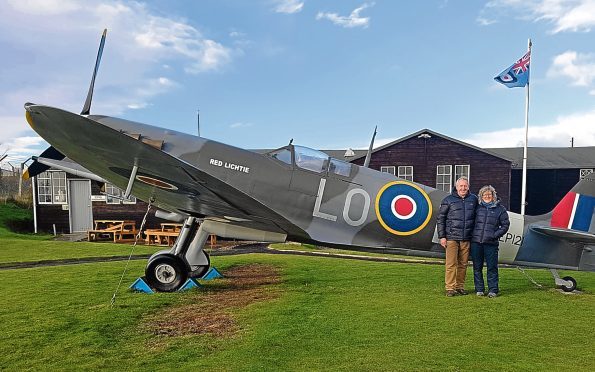The Doyenne and I have been entertaining her New Zealand niece and her fiancé, who we were meeting for the first time. We had ideas of interesting places to go but a month living out of suitcases saw Claire and Graham opt to stay close to home so we spent an informative morning at the Montrose Air Station Heritage Centre.
The air station was built in 1913 on Kinnaber Moor, at the north end of Montrose. Protected from easterly storms by the seaward ridge of sand dunes, the moor stretches from the town boundary to the River North Esk. Over the years I’ve walked over most of it, usually with a dog for company.
I explained how wildlife on the moor has declined. The light, easily-drained, sandy soil and patchwork of gorse provided cover and an ideal environment for a large population of native grey partridge. There are a lot of reasons for their decline but I should be surprised and delighted to see any on the moor now. My father remembered quail, cousins of partridge and summer visitors to the north-east to breed, appearing on the moor around May – long gone now.
An unusual strain of ginger hares, the only place that I knew of them, disappeared years ago. Eider duck nested on the moor but they seem to be a thing of the past too. Skylarks’ song was a feature of spring and summer – not so now.
New Zealand
I wanted to know about New Zealand’s wildlife. Claire grew up in the Doyenne’s home town of Bradford but spent every available moment of her teenage years working on Yorkshire Dales farms. She got an agricultural degree, went off to be a sheep farmer in New Zealand, and married the boss’s son. Her life took another direction and she recently retired as husbandry manager for the largest kiwi hatchery in New Zealand, at Rotorua.
The story she told of New Zealand’s wildlife management, or perhaps mismanagement, mirrors what has gone on all over the world, no less here in Britain.
It was Captain Cook who first mapped New Zealand in 1768, at which time the two islands had no predator species. The only mammals were three species of bat and marine mammals such as seals, dolphins and whales.
Because of the lack of human presence and predator species, birds had evolved into niches that would otherwise have been inhabited by mammals. Thus, kiwis evolved to become the avian version of hedgehogs – ground dwelling and insect eating.
Cook is said to have been amazed by the cacophony of native birdsong when he landed for the first time. That all changed as Europeans began to develop the islands. The wild pigs on the islands are known as Captain Cookers, as their ancestors were originally introduced by him.
Over the centuries British songbirds, possibly caged pets of sailors, were released on to the islands. Today sparrows, thrushes, blackbirds, goldfinches and other finches are commonplace but non-native New Zealand species.
Not just rabbits
Rabbits were introduced but, as happened in Australia, their numbers exploded and they became a major pest. Predator species – stoats, weasels and ferrets – were brought in as a biological control, but the predators attacked the native species such as the flightless kiwis, which were defenceless against them, causing a dangerous imbalance in the natural ecology.
The same unintended result followed the introduction of non-native hedgehogs to South Uist in the Outer Hebrides, which ate the eggs of ringed plover, lapwings, oystercatchers and other ground-nesting waders, causing their numbers to plummet.
Kiwi chicks in the wild have only a 5% chance of survival because of human-introduced predators. The kiwis had become endangered almost to the point of extinction when a national breeding scheme was established.
As New Zealand’s early agriculture developed cows, sheep and goats were shipped out along with cats, dogs and other domestic animals. Pheasants, quail, hares, red deer, roe deer, fallow and sika deer all followed as non-native introductions to New Zealand.
Prickly problem
It didn’t stop there – the native Scottish prickly gorse was planted as natural stock fences and shelter belts. It spread aggressively and now, like Japanese knotweed in this country, is regarded as an invasive, non-native species.
Wallabies, introduced for sport and the value of their skins, compete for food with sheep – one of New Zealand’s most important exports after rugby. An eradication scheme is in place and some are even being repatriated to their native Australia where they are an endangered species in parts. Possums – for fur farming – were also introduced. The scheme collapsed and there are now more possums in New Zealand than parts of their native land.
You can’t avoid the thought that we humans never learn. If we want to influence nature we have to think out of the box and think through the consequences of our actions. After all, nature was flourishing long before our fishy ancestors flopped on to land to eventually evolve into homo sapiens – wise man. Oh! So that’s what we are.


